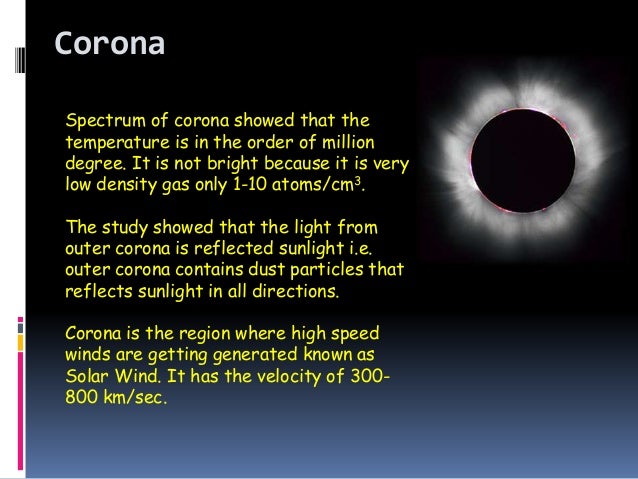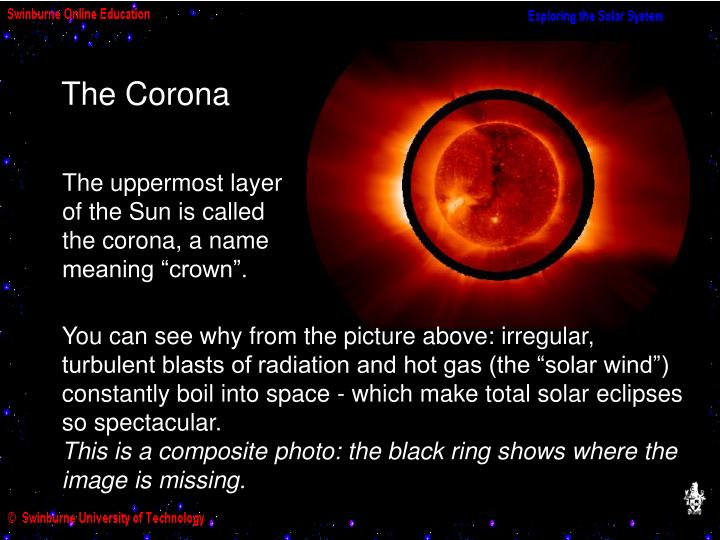

When there are solar flares from the corona, larger than normal amounts of energy interact with our atmosphere, causing disruptions to power grids and satellite communications. There is still much to be learned about the corona! Studying the Coronaīecause of the high temperatures in the corona, particles are moving at a high enough speed to escape the Sun’s gravity and travel through space as solar wind. Another idea is that solar tornadoes, which are giant vertical spirals of plasma that interact with the Sun’s magnetic field, could also lead to high coronal temperatures. It’s possible that millions of nanoflares, which are tiny explosions happening at the solar surface, are creating the energy that heats up the corona.

Researchers aren’t sure exactly why the corona is so hot. The corona is much hotter than the Sun's surface, about 1 million ☌ compared to 5,500 ☌ (9,940 ☏). Why is the Corona So Much Hotter Than the Surface of the Sun? The corona is wispy, white streamers of plasma (charged gas) that radiate out from the surface of the Sun. During a total solar eclipse, the corona briefly comes into view as the Moon blocks out the light from the solar surface. The surface of the Sun is far too bright to allow a glimpse of the much fainter solar atmosphere. Earth actually orbits within the atmosphere of a star! We Can’t Usually See the Corona The solar wind is really just an extension of the Sun's atmosphere that engulfs all of the planets. It extends many thousands of kilometers above the visible surface of the Sun, gradually transforming into the solar wind that flows outward through our solar system. The uppermost portion of the Sun's atmosphere is called the corona. The wisps of plasma are typically hidden by the brightness of the Sun’s surface. 248, 256–262 (1991).The Sun’s corona is visible during a total solar eclipse. Interplanetary Dynamical Process (Interscience, New York, 1963). in Wave Propagation in Random Media (Scintillation) (eds Tatarskii. I estimate the size of the smallest filamentary structure within coronal holes to be about 1km at the Sun, approximately three orders of magnitude smaller than the smallest filamentary structures observed in images of different wavelengths 2,10–12.

Here I argue that these features are the manifestation of a transition from small ray-like or filamentary structures in the corona that rotate with the Sun to turbulent density irregularities convecting with the solar wind. Two specific features that have proved difficult to explain are an abrupt increase in anisotropy of the irregularities close to the Sun 5–7, and a break in the power-law spectrum describing the density fluctuations 8,9. Radio measurements have established many of the characteristics of the density fluctuations in the corona and solar wind, but the fundamental nature of these structures is not yet fully understood 3,4. The structure can be investigated directly by imaging at optical and shorter wavelengths, or indirectly through the effects of changing electron density on the propagation of radio waves (scattering and scintillation). KNOWLEDGE of the structure of the Sun's corona is important for our understanding of how this high-temperature plasma is heated, and of the processes involved in the acceleration of the solar wind 1,2.


 0 kommentar(er)
0 kommentar(er)
